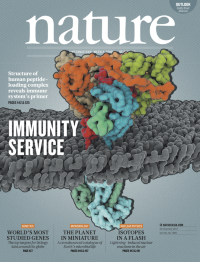Volume 551
-
No. 7682 30 November 2017
The cover image shows the muscle fibre network of the planarian Schmidtea mediterranea. Planarian muscle is host to the expression of many of the genes that help to direct where regenerating cells are positioned, a crucial aspect for properly controlling the regeneration of missing body parts. Previous work has identified position control genes but how they exert their effects has remained unclear. In this issue, Peter Reddien and his colleagues show that the regeneration of different types of muscle fibres is controlled by different transcription factors: myoD is needed to regenerate longitudinal fibres, whereas nkx1-1 is needed for the formation of circular fibres. They find that loss of longitudinal fibres leads to complete regeneration failure, whereas loss of circular fibres results in two heads regenerating instead of one. As a result, the authors suggest that different muscle types have distinct roles in orchestrating regeneration through controlling wound signalling and patterning. Cover image: M. Lucila Scimone and Kutay Deniz Atabay
-
No. 7681 23 November 2017
The cover image shows the structure of the human peptide-loading complex (PLC) spanning the endoplasmic reticulum membrane of a cell (grey). As a key component of the immune response, the PLC is a dynamic complex responsible for loading peptide fragments from foreign bodies such as viruses onto major histocompatibility complex class I (MHC-I) molecules. These in turn present the fragments to the bodyâs immune cells to initiate the systemâs fight back against the invaders. Robert Tampã© and his colleagues used electron cryo-microscopy to reveal the structure of the PLC, showing how the editing modules of the complex are centred around the peptide transporter TAP. They also find that loading the antigenic peptides onto MHC-I induces changes in its structure, thereby facilitating the release of stable peptideâMHC-I complexes to start the immune response. This allows the researchers to offer a glimpse of the mechanism behind the PLC, antigen processing and the way immunity mediated by MHC-I is induced. Cover image: Arne Moeller (MPI of Biophysics), Simon Trowitzsch and Robert Tampã© (Goethe Univ.)
-
No. 7680 16 November 2017
The cover image depicts colonies derived from human epidermal stem cells (holoclones). Transgenic holoclones from a 7-year-old boy were used to reconstruct his damaged skin. A severe case of junctional epidermolysis bullosa, a genetic disorder in which the integrity of the skin is compromised, meant that much of the boyâs skin developed chronic blisters and wounds. In this weekâs issue, Michele De Luca and his colleagues describe how they approached the boyâs treatment. A viral vector was used to transduce stem cells derived from the patientâs skin with a functional version of the affected gene, in this case a mutated î3 chain of laminin-332. These stem cells were then used to grow large sheets of functional epidermis that could be used as surgical grafts to replace 80% of the boyâs skin. The research also provided insight into the generation of the epidermis and revealed that it is sustained by defined, long-lived stem cells. An accompanying News & Views piece explores the limitations and wider implications of the technique, including the potential of translational research to guide combinatorial stem-cell and gene therapies to treat otherwise incurable diseases. Cover image: Sergio Bondanza & Francesca La Mantia/Centre for Regenerative Medicine âStefano Ferrariâ & Holostem Terapie Avanzate
-
No. 7678 2 November 2017
The cover image depicts an artistâs impression of the merger of two neutron stars, giving rise to a low-luminosity transient object called a kilonova. Just such an event was observed on 17 August 2017 by the Advanced LIGO and Virgo detectors, initially in the form of gravitational waves. Importantly, this event, called GW170817, was accompanied by strong electromagnetic signals that were observed by a number of facilities. As a result, a significant amount of information has been gathered about the resultant gamma-ray burst, and six papers and a News & Views in this issue examine the details of the kilonova. Optical and near-infrared emissions from the event are reported in three papers by Iair Arcavi and his colleagues, Elena Pian and her team, and Stephen Smartt and his colleagues, affirming that GW170817 was indeed a kilonova. Eleonora Troja and her colleagues report on X-ray emissions from the merger, which indicate that the ejecta jet from GW170817 was seen somewhat off axis. In a fifth paper, Daniel Kasen and his collaborators examine the production of heavy elements in the kilonova event, using the latest observations to help constrain their predictions; they suggest that neutron-star mergers provide most of the heavy elements in the Universe. And Daniel Holz along with teams at multiple observatories managed to use the kilonova to independently re-calibrate the Hubble constant, getting a result that is consistent with other determinations. Cover image: Aurore Simonnet





